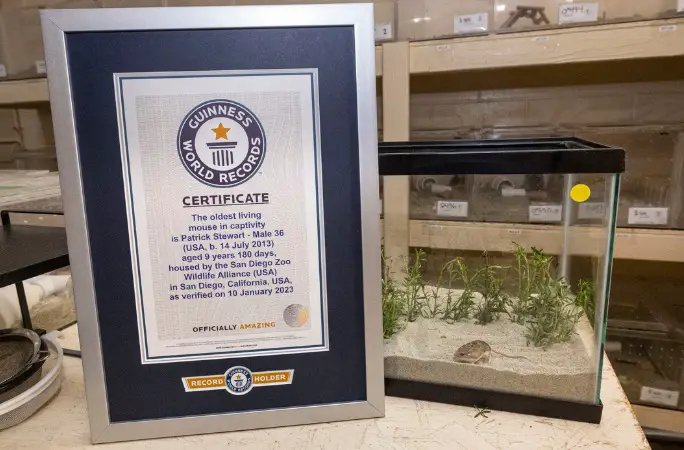A mouse named Patrick Stewart (in tribute to the iconic actor), has been verified by the Guiness World Records as the oldest living mouse in human care as well as the oldest mouse ever, aged 9 years 210 days as of 9 February 2023.
Patrick’s age is unprecedented for a mouse. He’s almost two years older than the previous oldest mouse ever recorded, Fritzy (1977-1985), who was owned by Bridget Beard (UK) and lived to the age of 7 years 225 days.
Pat is a Pacific pocket mouse, which is North America’s smallest mouse species and was thought to be extinct until a small population was rediscovered in 1994.
The record-breaking rodent was born on 14 July 2013 in the Pacific Pocket Mouse Breeding Facility at San Diego Zoo Safari Park, where he has lived his entire life.
Pat’s birth date has been confirmed via multiple medical records and animal record logs.
He was produced by two wild-caught parents and was born with one other male littermate, during the first year of the zoo’s Pacific pocket mouse conservation, breeding and reintroduction program.
Although Pat has never sired a litter himself, “he still tries,” according to Dr Debra Shier, who monitors Pat at the breeding facility.
“He has been paired 32 times with 23 different females and while he exhibited good courtship behavior (sandbathing, slow approach and digging), females were extremely aggressive in mate pairings with him,” Dr Shier explained.
“He came closest to mating in his pairing this year as a nine-year-old male and may have mated if the trial wasn’t stopped due to a time limit of two and a half hours.”

The average lifespan of a Pacific pocket mouse in the wild is one to two years; in captivity it can increase to four to six years.
Weighing about the same as three pennies, the endangered rodent gets its name from the pouches in its cheeks which are used to carry food and nesting materials.
Though small, these mice play a crucial role in their ecosystems by dispersing the seeds of native plants and encouraging plant growth through their digging activities.
According to the San Diego Zoo Wildlife Alliance, receiving this Guinness World Records title is a win for the small, often-overlooked species.



























